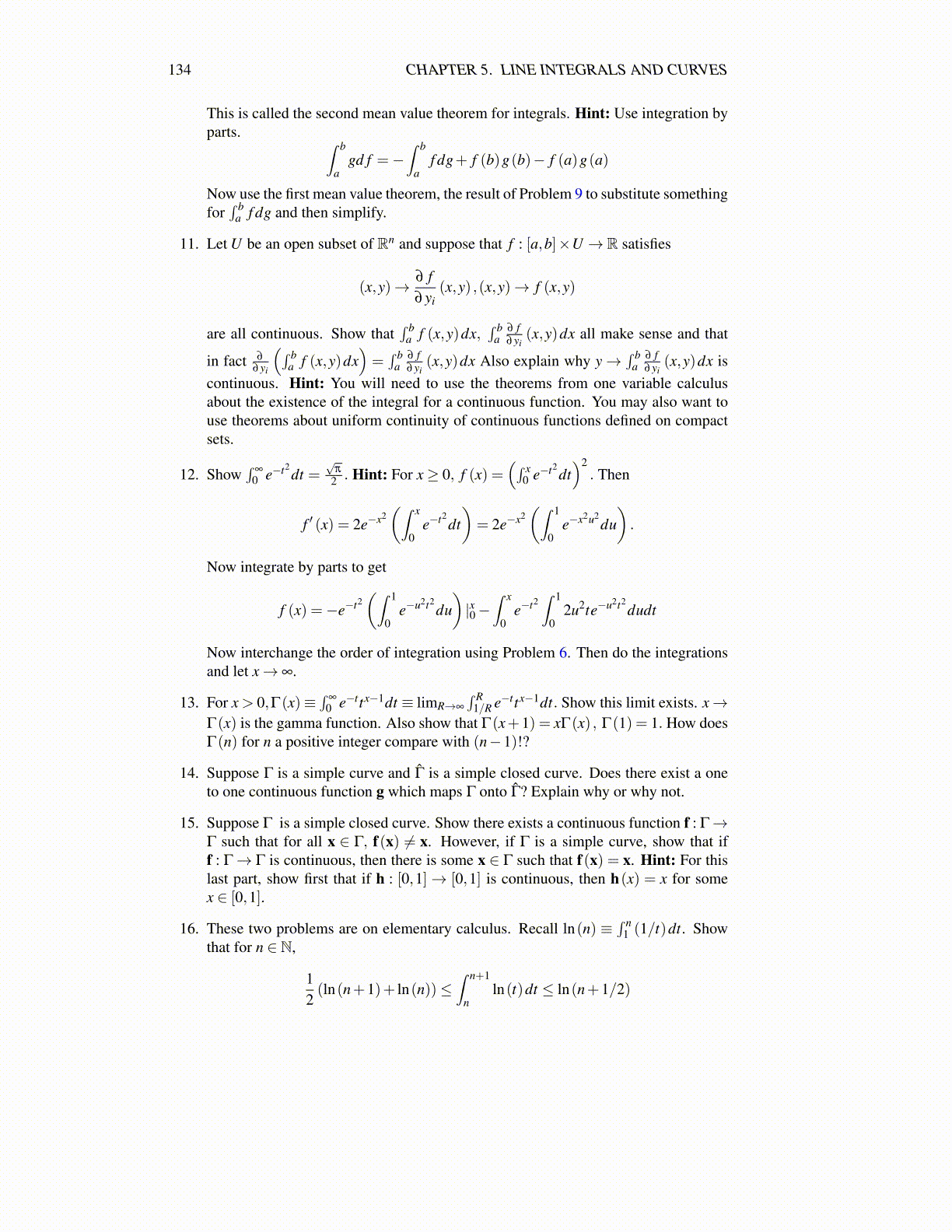
134 CHAPTER 5. LINE INTEGRALS AND CURVES
This is called the second mean value theorem for integrals. Hint: Use integration byparts. ∫ b
agd f =−
∫ b
af dg+ f (b)g(b)− f (a)g(a)
Now use the first mean value theorem, the result of Problem 9 to substitute somethingfor∫ b
a f dg and then simplify.
11. Let U be an open subset of Rn and suppose that f : [a,b]×U → R satisfies
(x,y)→ ∂ f∂yi
(x,y) ,(x,y)→ f (x,y)
are all continuous. Show that∫ b
a f (x,y)dx,∫ b
a∂ f∂yi
(x,y)dx all make sense and that
in fact ∂
∂yi
(∫ ba f (x,y)dx
)=∫ b
a∂ f∂yi
(x,y)dx Also explain why y→∫ b
a∂ f∂yi
(x,y)dx iscontinuous. Hint: You will need to use the theorems from one variable calculusabout the existence of the integral for a continuous function. You may also want touse theorems about uniform continuity of continuous functions defined on compactsets.
12. Show∫
∞
0 e−t2dt =
√π
2 . Hint: For x≥ 0, f (x) =(∫ x
0 e−t2dt)2
. Then
f ′ (x) = 2e−x2(∫ x
0e−t2
dt)= 2e−x2
(∫ 1
0e−x2u2
du).
Now integrate by parts to get
f (x) =−e−t2(∫ 1
0e−u2t2
du)|x0−
∫ x
0e−t2
∫ 1
02u2te−u2t2
dudt
Now interchange the order of integration using Problem 6. Then do the integrationsand let x→ ∞.
13. For x > 0,Γ(x)≡∫
∞
0 e−ttx−1dt ≡ limR→∞
∫ R1/R e−ttx−1dt. Show this limit exists. x→
Γ(x) is the gamma function. Also show that Γ(x+1) = xΓ(x) , Γ(1) = 1. How doesΓ(n) for n a positive integer compare with (n−1)!?
14. Suppose Γ is a simple curve and Γ̂ is a simple closed curve. Does there exist a oneto one continuous function g which maps Γ onto Γ̂? Explain why or why not.
15. Suppose Γ is a simple closed curve. Show there exists a continuous function f : Γ→Γ such that for all x ∈ Γ, f(x) ̸= x. However, if Γ is a simple curve, show that iff : Γ→ Γ is continuous, then there is some x ∈ Γ such that f(x) = x. Hint: For thislast part, show first that if h : [0,1]→ [0,1] is continuous, then h(x) = x for somex ∈ [0,1].
16. These two problems are on elementary calculus. Recall ln(n) ≡∫ n
1 (1/t)dt. Showthat for n ∈ N,
12(ln(n+1)+ ln(n))≤
∫ n+1
nln(t)dt ≤ ln(n+1/2)